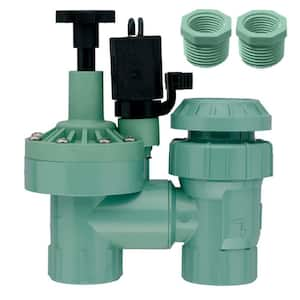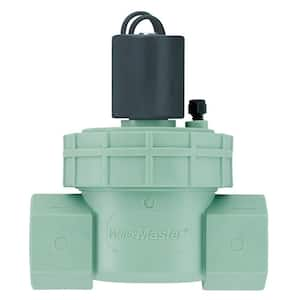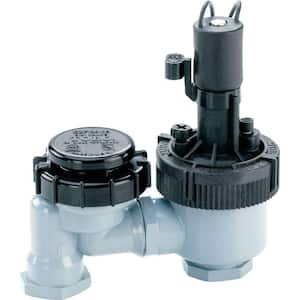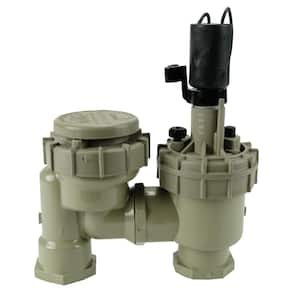Questions and Answers for Orbit 1 in. FPT Anti-Siphon Valve with 3/4 in. Reducer
Internet #203757013
Model #57604
Store SKU #387879
- Resilient ABS plastic material is resistant to heat and impact
- Anti-siphon feature automatically prevents water contamination
- Adjustable Flow reduces mist formation and excessive spraying
Questions & Answers
A: There is no science to instal , no polarity on the coil and every item well marked
A: You can access the manual online at https://www.orbitonline.com/site_files/manuals/57623-24%20rE_2.pdf.
A: I have had the same problem, I would contact Orbit direct. Sorry not much help. Tom
A: Please contact our Support team at 1-800-488-6156 or via social media, and we'd be happy to help.
A: I connected mine thru a ball valve directly to the street supply. I found the higher pressure advantageous. It's been working for over 35 years now.
A: If you have a PRV already, I would install after that. Per the book, the ideal pressure is 30PSI. However, what I believe is nice about this system is you can use the knob to set a perfect PSI for your system and adjust it on the fly to be tailored to your needs.
A: Freshmangreen, we can't speak to what an "optimal" system would have, in terms of water pressure. The typical household has somewhere between 40 and 60 PSI, if that answers your question. This valve should be completely fine for your system, as long as your water pressure isn't off-the-charts high. We recommend you first determine what your water pressure is before you start considering use of a pressure reducer for your valves.
A: Because your sprinklers heads are outdoors and working in a muddy environment, when they shut off, some back pressure occurs and some sediment can slowly enter the sprinkler lines and over time force its way back into your main water supply. This device between the sprinkler system and the main water supply prevents that sediment from ever entering your main house water supply.
A: Janet, this is not a common occurrence, to say the least. It happens several times a year across the country, usually in an instance like the example below: 1. You have a garden hose connected to culinary (drinking) water and you are using that hose to fill your duck pond, so you place the end of the hose in the duck pond. 2. While performing a plumbing repair, the plumber turns off the water supply to your home. 3. Someone in your house then flushes a toilet in the basement, while the garden hose is still submerged in the duck pond’s non-potable (non-drinking) water. 4. The water in your home's closed water supply system rushes to the lowest point, in reaction to the flushed toilet, and there is no way for air to get into the system. Eventually, a vacuum is created in the line, which - without the correct vacuum breakers installed - can siphon water from your duck pond, your sink full of food-caked dishes, or whatever you have connected to your drinking water system. That water might be siphoned back into your potable water system. 5. This might also happen on the main line connected to your house. The city may have a line break and during those repairs, a vacuum can siphon contaminated water back into the public water supply. Air gaps, anti-siphon valves, pressure vacuum breakers and RP devices are all intended to prevent backflow or back-siphonage from happening. 6. Backflow is a little different, if you have a secondary water source - maybe a canal - from which you pump irrigation water into your sprinkler system on a seasonal basis when that canal water is available. When the canal is not available, you may have a system of valves that allow you to use your sprinkler system through the culinary water system. If you make a mistake and open/ close the wrong sequence of valves, in that scenario you may end up with 80 PSI canal water being pumped into a culinary water system at 40 PSI. As 80 PSI is much greater than 40 PSI, that would fill the public drinking water system with canal water, unless you have the correct water protection back-pressure systems in place to prevent these scenarios.
A: These valves have a solenoid that operates from 24 Volt Alternating Current. I believe the battery powered unit provides 24 Volt Direct Current. This will destroy a solenoid that is supposed to run from AC or it will quickly discharge the battery, either way it will not work.
A: Ccnj, yes this valve would be compatible. You would need the battery-operated timer (57860), as well as the solenoid specially designed for that timer (57861).
A: From what I can tell, you can't switch out the solenoid without breaking it. There is a stop that prevents it from turning around fully to be replaced. You could break off the plastic stop to do it. However, electric solenoids are pretty standard devices and this likely will work fine with your system. You just need to make sure you have an electric connection in your system to turn the water on and off to all of your sprinkler stages. That assumes you are using one for all of your stages. If you are using one of each stage, then you should be able to connect your stage connection directly to this. That also gives you the ability to adjust pressure differently to each stage of your system.
A: It is really made to be used with an electric system. The manual knob is meant to control water pressure into the sprinkler system. I am not sure if it will complete cut off the water but it is really not made as an on/off system. You can also manually turn the electric solenoid to quickly turn the water on and off. However, the directions state that this is only intended for rare instances and the solenoid can leak if used too often.
A: It will work but I had one valve that would not stop leaking where the knob screws into the valve. It looks like a weak area subject to leaking, Get a controller as soon as possible.
A: Unfortunately, there are many things that could be causing your problem. It could be that your solenoid is bad and installing this, which includes a new solenoid could fix your problem. It could be a bad electric connection or wire to the solenoid. It could be a bad or faulty control system. Personally, I would start ensuring that your electric connections are working. This replace the solenoid, then replace the control unit in that order to try to solve the problem.
A: Check your programming that may be it
A: Sprinklerguy, there are several reasons why this might be happening. The cheapest and easiest thing to try first is to see if the flow control knob has the valves closed: Turn the flow control handle on the valve as far as it will go counter clock-wise, then turn the valve on. Next would be to use a voltmeter to determine if your timer is outputting voltage (confirming that the timer is functioning normally): When zone 1 is “on,” put the voltmeter to measure AC voltage and put one probe on the common “C” and the other on Zone “1,” You should read 23 to 26 volts. Next to make sure the voltage is being received at the valves to confirm the wires have not been cut somehow. You could use a voltmeter again, but if you do not have a volt meter, turn off the water pressure to your system and remove the solenoid from the lid of the valve and confirm that the solenoid piston moves in and out as you turn the valve on and off electrically. If the solenoid piston for zone 1 does not move in and out as the zone is turned on and off, but you know that the voltage is being delivered through the wires, you could have a bad solenoid or corroded connection between the sprinkler wires and solenoid wires. If you have only one bad valve on a manifold of 2 or more valves, you can swap solenoids or valve lids to see if the issue follows the solenoid or lid. That would help narrow down the scope of the problem. If none of the above attempts have not resolved the issue, please give our Support team a call at 1-800-488-6156. We'd be more than happy to help in any way we can, so your sprinkler system works properly. Thanks!
Compare Similar Items
current item | |||
Irrigation System Component | |||
|---|---|---|---|
Valve | Valve | Valve | Valve |



























